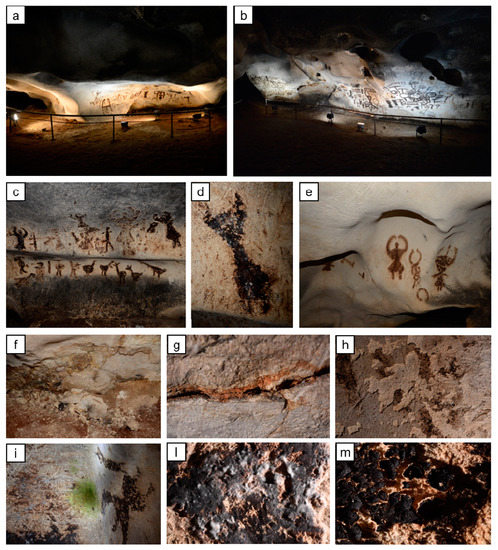This study is aimed at evaluating the effectiveness and the compatibility of two alternative treatments, in view of their possible use for conservation of prehistoric paintings in the Magura cave (Bulgaria). The paintings are made of bat guano applied over limestone, therefore two sets of laboratory specimens were considered: stone specimens and stone specimens covered with a layer of sterilized bat guano. The two investigated treatments were a commercial product based on ethyl silicate (“ES”) and a solution of diammonium hydrogen phosphate (“DAP”), aimed at forming calcium phosphates. The results of the study indicate that both treatments were able to increase mechanical properties of stone, the increase being higher for “DAP”. Both consolidants caused acceptable color changes, but the “ES” treatment significantly decreased stone wettability, water absorption and water vapor permeability, while the “DAP” treatment slightly affected those properties. In the stone+guano specimens, the presence of the guano layer affected the penetration of the consolidants, thus partly reducing their effectiveness. Compared to the stone samples, the guano layer experienced a more intense color change, alongside visible cracking. However, the adopted methodology to replicate the cave paintings was not completely successful, as the so-deposited guano layer was very prone to detachment when dry, unlike cave paintings. Future work will be dedicated to assess the consolidant performance onto samples that resemble even more closely the conditions of the cave paintings, by improving the methodology for the guano layer deposition and by contaminating specimens with soluble salts before consolidant application.
- Cave painting
- Inorganic consolidant
- Hydroxyapatite
- Calcium phosphate
- Ammonium phosphate
- Ethyl silicate
- TEOS
- Non-thermal plasma
- Wettability
The present studyaimed at investigating the effectiveness and the compatibility of two treatments that have been taken into consideration for the conservation of prehistoric paintings in the Magura cave (northwest Bulgaria). The Magura cave contains impressive prehistoric paintings, displaying both figurative and abstract compositions [1]. Religious ceremonies, hunting scenes, signs, and graphic motifs decorate one of the cave chambers—the Gallery with the paintings (Figure 1).

These artworks, dating back to some 5500 years ago, are made of fossilized guano of cave-dwelling bats applied over limestone [2,3,4,5]. After opening to the public in 1961, with the consequent presence of visitors and the use of artificial light, the delicate balance of environmental conditions inside the cave has been altered. Despite the cultural relevance of the Magura Cave, unfortunately, the micro-environmental data, such as temperature, relative humidity, CO2 concentration, and atmospheric pressure, have never been professionally measured and controlled. Today, the cave suffers from biological colonization and stone pulverization, originated by crystallization of soluble salts present in rising damp from the ground. Deterioration patterns, such as green biofilm and white and black colorations over the stone/paintings surface, together with limestone powdering, blistering, and fragmentation [6] (Figure 1), led to the closure of the Gallery in May 2019.
The preservation of the cave paintings requires challenging interventions to face the growth of bio-organisms and the deterioration of the stone. As for biological growth, the use of biocides is dangerous because they may completely alter the balance of microbial communities in the cave with negative consequences [7]. For this reason, biodeactivation by non-thermal plasma sterilization has been attempted, and some encouraging results have been obtained [8]. As for stone consolidation, the issue is particularly challenging for the following reasons: (1) the presence of the guano layer creating the paintings; (2) the presence of soluble salts inside the stone pores; (3) the environmental conditions in the cave. In these conditions, the selection of consolidants to be tested and possibly applied in the Magura cave is very hard, as none of the commercially available treatment seems ideal for application onto the limestone and the paintings in the cave.
We investigated the performance of an innovative phosphate consolidant, proposed in the literature a few years ago, in comparison with a commercial alternative based on ethyl silicate, selected because of its widely diffused use. The performance of the two consolidants was tested onto stone and stone+guano laboratory specimens and characterized in terms of effectiveness (penetration depth, dynamic elastic modulus and resistance to abrasion) and compatibility (alterations in color, pore size distribution, contact angle, water sorptivity and water absorption, water vapor permeability).
The innovative phosphate treatment proved to be more effective and more compatible than the commercial alternative based on ethyl silicate. Future research will further validate the findings of the present study, by testing the consolidants also on salt-contaminated specimens.
This entry is adapted from the peer-reviewed paper 10.3390/coatings10030250
